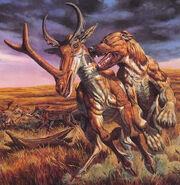
Epicyon (meaning "more than a dog" in greek, its pronounced epp-ih-SIGH-on) is a large extinct canid genus of the subfamily Borophaginae ("bone-crushing dogs"), native to North America. It lived from the Hemingfordian age of the Early Miocene to the Hemphillian of the Late Miocene (20.6—5.330 Mya. Epicyon existed for about 15.5 million years. It was about 5 feet long, and its weight has been estimated at 150 lbs. Some sources state 200-300 pounds. Epicyon had a massive head and powerful jaws, giving its skull a lionlike shape (rather than that of a wolf).
Description[]
Taxonomy[]
Epicyon was first named by Joseph Leidy in 1858 as a subgenus of Canis. It was also mentioned as belonging to the Aelurodontina by Matthew and Stirton in 1930. Later studies indicates that it was not a species of Canis, but a borophagine.
Fossil range[]
Fossil specimens range from Florida to Alberta, Canada to California; from Nebraska, and Kansas to New Mexico and Texas.
Species[]
- Epicyon aelurodontoides existed for 10.3-4.9 million years. It was named by X. Wang and others in 1999. It was found south of the Young Brothers Ranch, Kansas.
- Epicyon haydeni existed for 20.6-5.3 million years. It is synonymous with Aelurodon aphobus, Osteoborus ricardoensis, Osteoborus validus, and Tephrocyon mortifer) and was named by Joseph Leidy as a subgenus. It was recombined as Aelurodon haydeni by Scott and Osborn in 1890. Further study by Matthew in 1899, Matthew and Gidley in 1904, VanderHoof and Gregory in 1940, McGrew in 1944, Bennett in 1979, (1979) and Becker (1980). It again was recombined as Epicyon haydeni by Baskin in 1980, Voorhies in 1990, (1990), Baskin (1998), Wang et al. in 1999. The largest known specimen weighed an estimated 170 kg (370 lb).
- Epicyon saevus existed for 16.3-4.9 million years. It is synonymous with Aelurodon inflatus and was named by Joseph Leidy in 1858 or 1859. In the late 1880s-early 1900s, Scott, Matthew, Cope and Matthew, Troxell recombined the animal as Aelurodon saevus. It was recombined as Epicyon saevus by Baskin in 1980, Munthe in 1989, Voorhies in 1990, and Wang et al. 1999.
Paleoecology[]
In North America, in places such as Coffee Ranch in Texas, Epicyon shared territory with the bear Agriotherium and the feliform Barbourofelis, machairodont cat Amphimachairodus coloradensis, and fellow canid Borophagus. All of these animals were potential competitors that would have occasionally conflicted with Epicyon for food and territory. Prey for Epicyon included herbivores such as the camel Aepycamelus, the pronghorn Cosoryx, horses such as Neohipparion and Nannippus, the peccary Prosthennops, and the rhinoceroses such as Teleoceras, all of which could provide a suitable meal through hunting or scavenging.
In popular culture[]
Epicyon appeared in the fifth episode of the 2009 paleodocumentary Monsters Resurrected, as well as in the 2019 adult animated TV show Primal.


